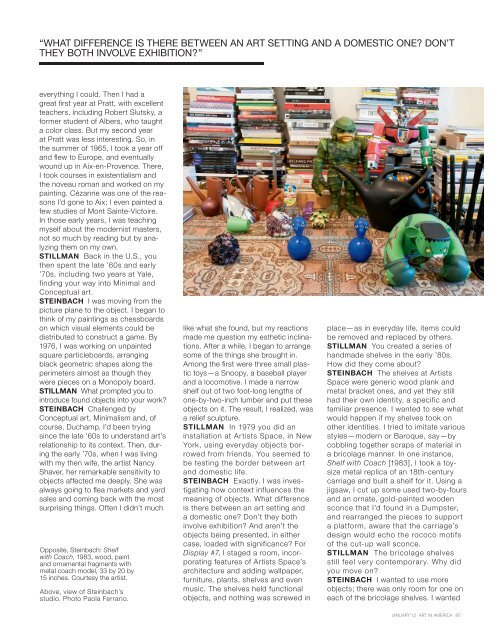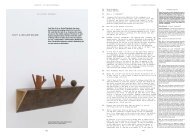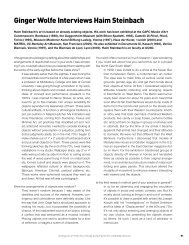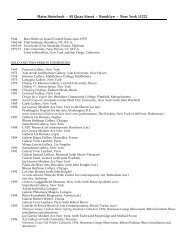Haim Steinbach in the Studio with Steel Stillman
Haim Steinbach in the Studio with Steel Stillman
Haim Steinbach in the Studio with Steel Stillman
Create successful ePaper yourself
Turn your PDF publications into a flip-book with our unique Google optimized e-Paper software.
“WHAT DIFFERENCE IS THERE BETWEEN AN ART SETTING AND A DOMESTIC ONE? DON’T<br />
THEY BOTH INVOLVE EXHIBITION?”<br />
everyth<strong>in</strong>g I could. Then I had a<br />
great first year at Pratt, <strong>with</strong> excellent<br />
teachers, <strong>in</strong>clud<strong>in</strong>g Robert Slutsky, a<br />
former student of Albers, who taught<br />
a color class. But my second year<br />
at Pratt was less <strong>in</strong>terest<strong>in</strong>g. So, <strong>in</strong><br />
<strong>the</strong> summer of 1965, I took a year off<br />
and flew to Europe, and eventually<br />
wound up <strong>in</strong> Aix-en-Provence. There,<br />
I took courses <strong>in</strong> existentialism and<br />
<strong>the</strong> noveau roman and worked on my<br />
pa<strong>in</strong>t<strong>in</strong>g. Cézanne was one of <strong>the</strong> reasons<br />
I’d gone to Aix; I even pa<strong>in</strong>ted a<br />
few studies of Mont Sa<strong>in</strong>te-Victoire.<br />
In those early years, I was teach<strong>in</strong>g<br />
myself about <strong>the</strong> modernist masters,<br />
not so much by read<strong>in</strong>g but by analyz<strong>in</strong>g<br />
<strong>the</strong>m on my own.<br />
STILLMAN Back <strong>in</strong> <strong>the</strong> U.S., you<br />
<strong>the</strong>n spent <strong>the</strong> late ’60s and early<br />
’70s, <strong>in</strong>clud<strong>in</strong>g two years at Yale,<br />
f<strong>in</strong>d<strong>in</strong>g your way <strong>in</strong>to M<strong>in</strong>imal and<br />
Conceptual art.<br />
STEINBACH I was mov<strong>in</strong>g from <strong>the</strong><br />
picture plane to <strong>the</strong> object. I began to<br />
th<strong>in</strong>k of my pa<strong>in</strong>t<strong>in</strong>gs as chessboards<br />
on which visual elements could be<br />
distributed to construct a game. By<br />
1976, I was work<strong>in</strong>g on unpa<strong>in</strong>ted<br />
square particleboards, arrang<strong>in</strong>g<br />
black geometric shapes along <strong>the</strong><br />
perimeters almost as though <strong>the</strong>y<br />
were pieces on a Monopoly board.<br />
STILLMAN What prompted you to<br />
<strong>in</strong>troduce found objects <strong>in</strong>to your work?<br />
STEINBACH Challenged by<br />
Conceptual art, M<strong>in</strong>imalism and, of<br />
course, Duchamp, I’d been try<strong>in</strong>g<br />
s<strong>in</strong>ce <strong>the</strong> late ’60s to understand art’s<br />
relationship to its context. Then, dur<strong>in</strong>g<br />
<strong>the</strong> early ’70s, when I was liv<strong>in</strong>g<br />
<strong>with</strong> my <strong>the</strong>n wife, <strong>the</strong> artist Nancy<br />
Shaver, her remarkable sensitivity to<br />
objects affected me deeply. She was<br />
always go<strong>in</strong>g to flea markets and yard<br />
sales and com<strong>in</strong>g back <strong>with</strong> <strong>the</strong> most<br />
surpris<strong>in</strong>g th<strong>in</strong>gs. Often I didn’t much<br />
Opposite, <strong>Ste<strong>in</strong>bach</strong>: Shelf<br />
<strong>with</strong> Coach, 1983, wood, pa<strong>in</strong>t<br />
and ornamental fragments <strong>with</strong><br />
metal coach model, 33 by 20 by<br />
15 <strong>in</strong>ches. Courtesy <strong>the</strong> artist.<br />
Above, view of <strong>Ste<strong>in</strong>bach</strong>’s<br />
studio. Photo Paola Ferrario.<br />
like what she found, but my reactions<br />
made me question my es<strong>the</strong>tic <strong>in</strong>cl<strong>in</strong>ations.<br />
After a while, I began to arrange<br />
some of <strong>the</strong> th<strong>in</strong>gs she brought <strong>in</strong>.<br />
Among <strong>the</strong> first were three small plastic<br />
toys—a Snoopy, a baseball player<br />
and a locomotive. I made a narrow<br />
shelf out of two foot-long lengths of<br />
one-by-two-<strong>in</strong>ch lumber and put <strong>the</strong>se<br />
objects on it. The result, I realized, was<br />
a relief sculpture.<br />
STILLMAN In 1979 you did an<br />
<strong>in</strong>stallation at Artists Space, <strong>in</strong> New<br />
York, us<strong>in</strong>g everyday objects borrowed<br />
from friends. You seemed to<br />
be test<strong>in</strong>g <strong>the</strong> border between art<br />
and domestic life.<br />
STEINBACH Exactly. I was <strong>in</strong>vestigat<strong>in</strong>g<br />
how context <strong>in</strong>fluences <strong>the</strong><br />
mean<strong>in</strong>g of objects. What difference<br />
is <strong>the</strong>re between an art sett<strong>in</strong>g and<br />
a domestic one? Don’t <strong>the</strong>y both<br />
<strong>in</strong>volve exhibition? And aren’t <strong>the</strong><br />
objects be<strong>in</strong>g presented, <strong>in</strong> ei<strong>the</strong>r<br />
case, loaded <strong>with</strong> significance? For<br />
Display #7, I staged a room, <strong>in</strong>corporat<strong>in</strong>g<br />
features of Artists Space’s<br />
architecture and add<strong>in</strong>g wallpaper,<br />
furniture, plants, shelves and even<br />
music. The shelves held functional<br />
objects, and noth<strong>in</strong>g was screwed <strong>in</strong><br />
place—as <strong>in</strong> everyday life, items could<br />
be removed and replaced by o<strong>the</strong>rs.<br />
STILLMAN You created a series of<br />
handmade shelves <strong>in</strong> <strong>the</strong> early ’80s.<br />
How did <strong>the</strong>y come about?<br />
STEINBACH The shelves at Artists<br />
Space were generic wood plank and<br />
metal bracket ones, and yet <strong>the</strong>y still<br />
had <strong>the</strong>ir own identity, a specific and<br />
familiar presence. I wanted to see what<br />
would happen if my shelves took on<br />
o<strong>the</strong>r identities. I tried to imitate various<br />
styles—modern or Baroque, say—by<br />
cobbl<strong>in</strong>g toge<strong>the</strong>r scraps of material <strong>in</strong><br />
a bricolage manner. In one <strong>in</strong>stance,<br />
Shelf <strong>with</strong> Coach [1983], I took a toysize<br />
metal replica of an 18th-century<br />
carriage and built a shelf for it. Us<strong>in</strong>g a<br />
jigsaw, I cut up some used two-by-fours<br />
and an ornate, gold-pa<strong>in</strong>ted wooden<br />
sconce that I’d found <strong>in</strong> a Dumpster,<br />
and rearranged <strong>the</strong> pieces to support<br />
a platform, aware that <strong>the</strong> carriage’s<br />
design would echo <strong>the</strong> rococo motifs<br />
of <strong>the</strong> cut-up wall sconce.<br />
STILLMAN The bricolage shelves<br />
still feel very contemporary. Why did<br />
you move on?<br />
STEINBACH I wanted to use more<br />
objects; <strong>the</strong>re was only room for one on<br />
each of <strong>the</strong> bricolage shelves. I wanted<br />
JANUARY’12 ART IN AMERICA 85





